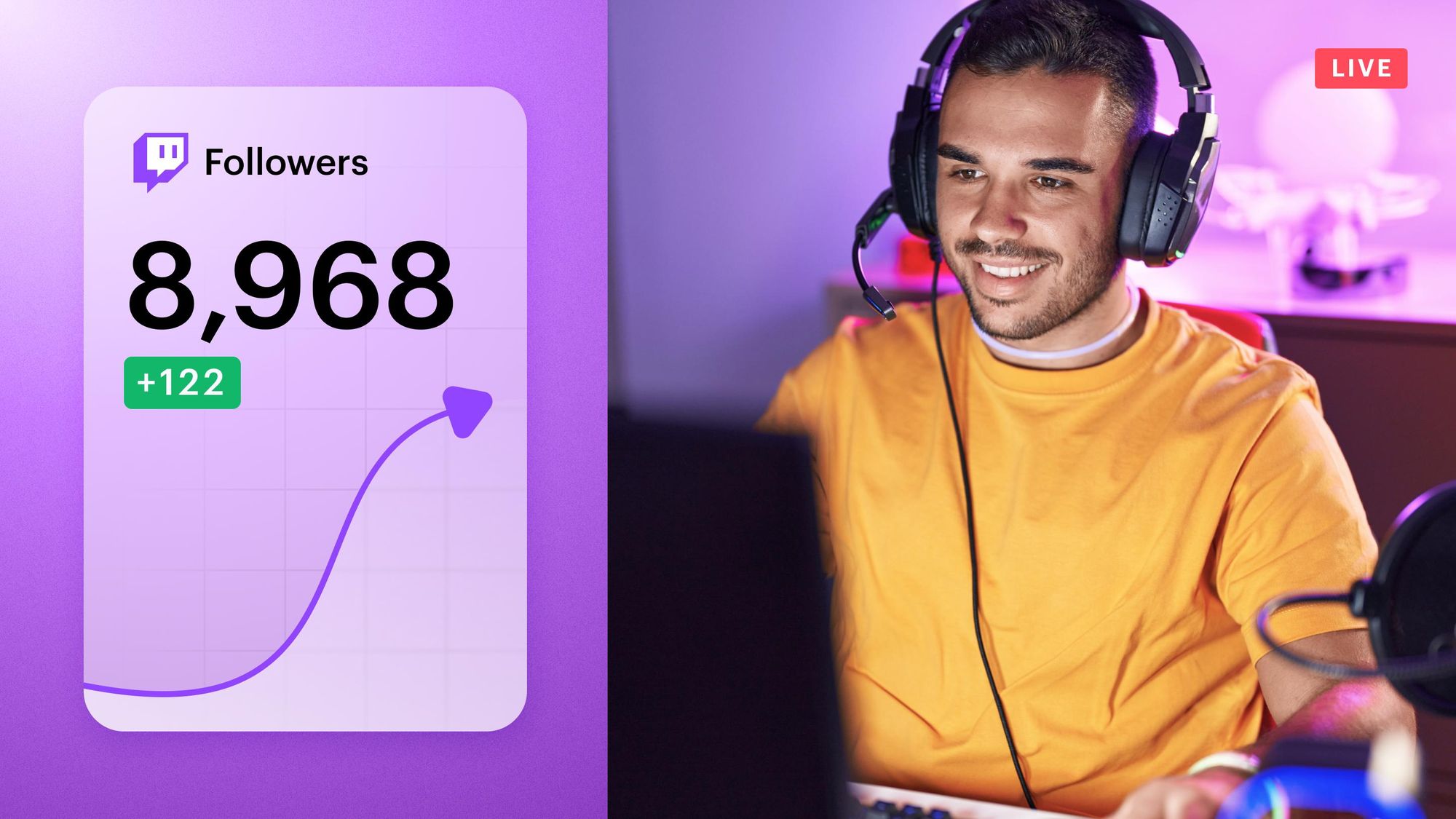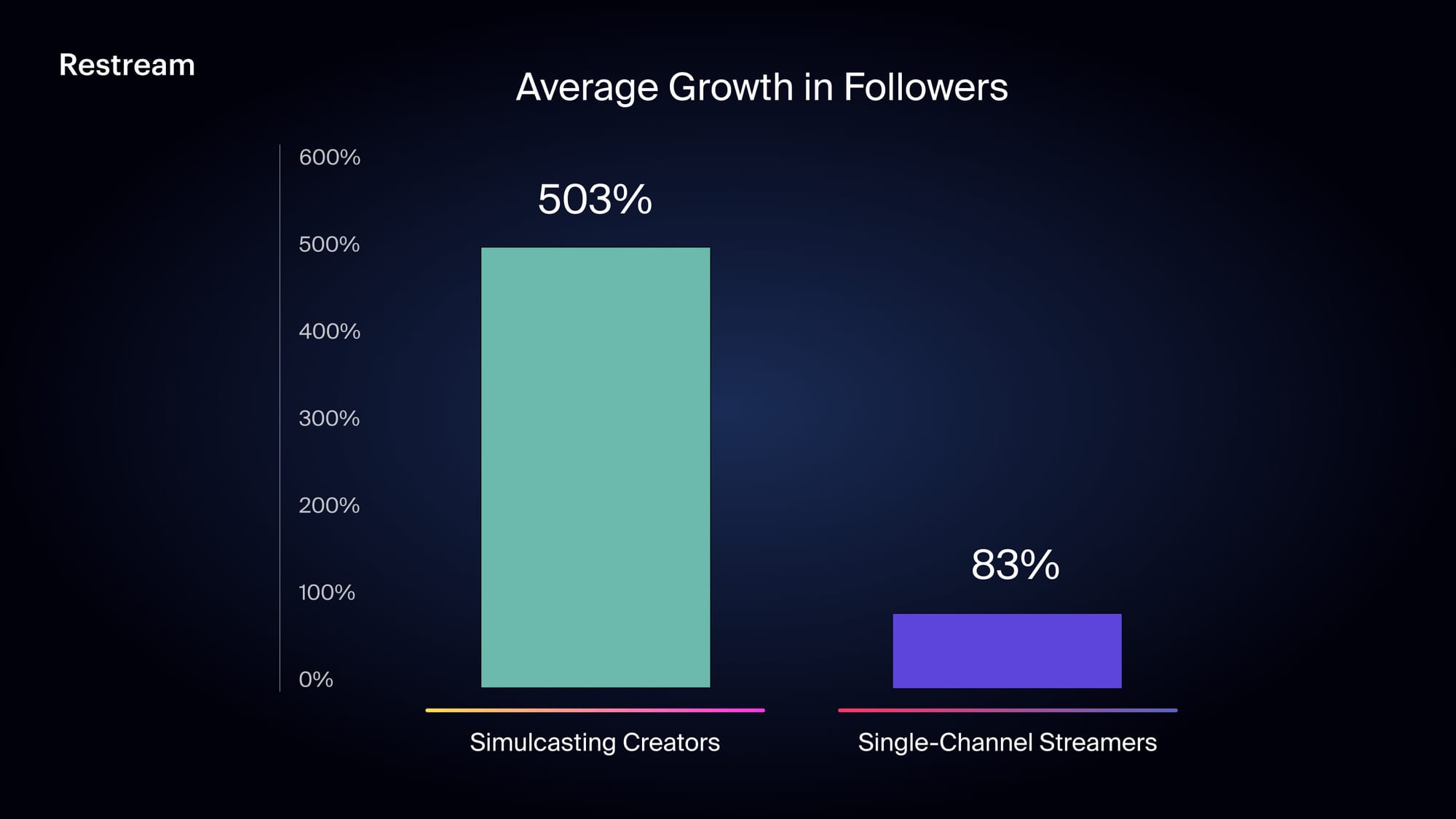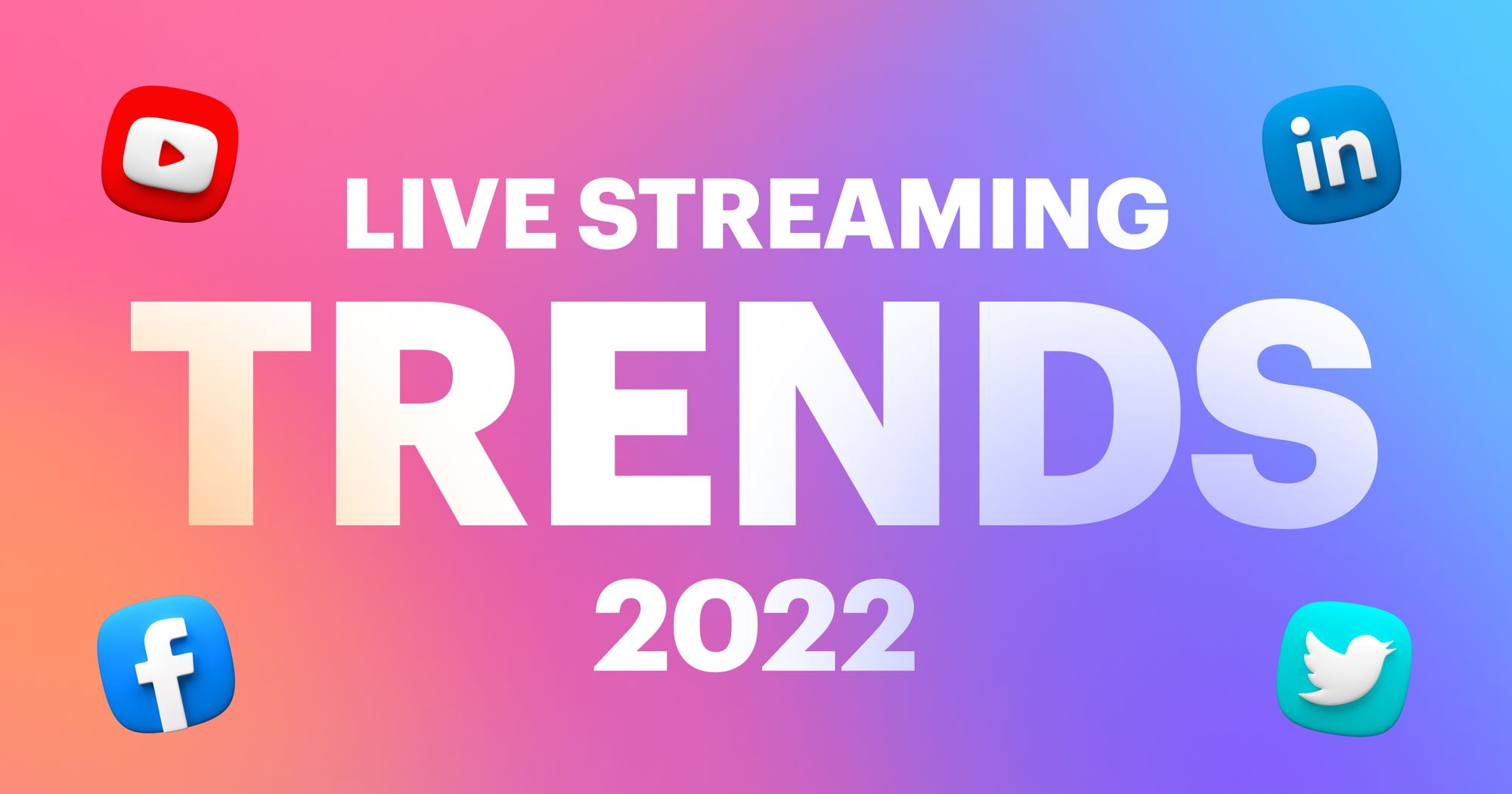Broadcasting live video over the internet — live streaming — continues to grow rapidly in popularity. For a long time, live streaming belonged primarily to the video game and esports industry, but in the last few years, it’s expanded to music, entertainment, business, tech and more.
With 7.6 billion hours of live content watched across all platforms in Q3 2023, it’s clear that live video is thriving. If you’re a marketer, entrepreneur, musician, athlete, artist or an aspiring content creator, live streaming could be key to helping you reach your customers or community.
But you’ll need a clear snapshot of the live streaming industry in 2024 to make that happen. We gathered the latest statistics about live video streaming so you can keep up on the latest trends.
Here are the highlights:
- 92% of internet users watch digital videos each week, and 27% of internet users watch live streaming content on a weekly basis.
- The global live streaming market grew from $1.24 billion in 2022 to $1.49 billion in 2023. It’s expected to reach $3.21 billion in 2027.
- 37% of social media users find live video content the most engaging type of in-feed content.
- The live stream that holds the record for the most concurrent views on YouTube is the Indian Space Research Organisation’s Chandrayaan-3 Mission Soft-landing telecast, with 8,090,676 concurrent viewers.
- 43% of 18-34-year-olds prefer to watch live video content on Instagram.
Online video consumption
We’ve seen viewer habits change steadily over the past decade or so. Now, with two new generations — millennials and Gen Z — coming into focus as part of the coveted demographic slice, it’s even more important to understand how much online video they’re watching, and how live video streaming fares against traditional, or linear, TV.
1. Traditional TV watching is declining but hasn’t gone away completely. 27% of Gen Zers and 34% of millennials watch linear TV daily. But it’s the older generations that are keeping linear TV popular — 38% of Gen Xers and 54% of baby boomers watch linear TV daily.
2. Of the people who still watch traditional TV every day, a whopping 72% consider themselves sports fans. Watching live-action sports might be a top reason that people hold on to traditional TV, rather than “cutting the cord.”
3. The number of pay-TV subscribers in the U.S. declines each year. Pay-TV companies lost 1.73 million net video subscribers during the second quarter of 2023 — compared to a 1.72 million net subscriber loss in Q2 2022.
4. Meanwhile, weekly online video consumption increases each year. Global consumers watched an average of 17 hours per week of online video in 2023.
5. Watching online videos is becoming more popular every year; 92% of internet users watch digital videos each week, and 27% of internet users watch live streaming content on a weekly basis.
6. Streaming videos is also becoming part of our daily routine, with 20% of U.S. adults between 18-34 watching live stream videos several times per day.
7. Online video seems to appeal more to younger internet users, however, as 24% of U.S. adults aged 35-54 and 47% of adults aged 55+ never watch live stream videos.
8. Watching videos, TV shows or movies is the fourth most popular reason people use the internet; 51% of global internet users aged 16-64 said it was their top reason for going online. The most popular reason for using the internet is finding information (59%), followed by staying in touch with friends and family (55%) and keeping up to date with news and events (51%).
9. In Q3 2023, live video streams were the third most popular type of online video, with 27% of internet video watchers consuming live video. The two types ahead of live streaming are: music videos (49%) and comedy videos (35%).
10. Live streams are among the most engaging types of content on social media as well, with 37% of consumers finding it the most engaging. Only short-form video and images were considered more engaging, with 66% and 61% respectively.
The most popular live streaming platforms
You can’t watch live streaming content online without platforms. When people think of streaming services they imagine Netflix, Hulu, Roku TV, and similar content platforms. But to watch live video, social networks like Facebook, YouTube, X (Twitter), LinkedIn, Instagram, and even Twitch have become the go-to platforms to both watch and broadcast live content.
11. Video-first platforms like Twitch and YouTube are still the biggest destinations for live streaming content. Twitch averaged 2.64 million concurrent viewers watching content in Q3 2022.
12. YouTube was the second-most-used social media platform in Q2 2023, with an average of 27 hours and 26 minutes per month per user (TikTok was first, with 33 hours and 38 minutes).
13. One of the top content categories for live streaming is video games (although other genres have been steadily gaining speed since 2020). Twitch and YouTube Gaming — the two biggest streaming platforms dedicated to video game streams) had a combined total of 5.488 billion watched hours for gaming content in Q3 2023 alone.
14. YouTube Live had more hours watched in Q2 2023 than Twitch, but Twitch’s gaming content far outstripped YouTube Live’s gaming content: 4.103 billion hours watched for Twitch games content and 1.385 billion hours watched for YouTube Live’s.
15. The new video streaming platform Kick arrived on the scene in early 2023 and made a splash by racking up one million users in its first few months.
16. Kick also had 167.8 million watched hours in Q2 2023 and surged to an impressive 296.84 watched hours in Q3 2023.
17. When viewers aren’t tuning into video games and esports, they’re also heading to social media platforms to watch live videos. In the U.S., 37% of live stream viewers aged 18-34 used YouTube Live for streaming content. Facebook Live was more popular for people aged 35-54.
18. Overall, live video does well on Facebook. People spend 3x more time watching a Facebook live video than one that’s no longer live.
19. Live video gets more engagement than pre-recorded videos on LinkedIn too: 7x more reactions and 24x more comments than other videos.
20. On mobile-first platforms like Instagram and TikTok, live streaming is more appealing to younger audiences. Instagram was the most popular platform used to watch live stream video content among 18-34 year-olds, with 43% of viewers saying it was their preferred platform. TikTok was the second most popular among this age group, with 41%.
21. Live videos are gaining steam on social media, but still not the number-one reason people use social networks. Gen X, millennials, Gen X, and baby boomers all cite keeping up with friends and family as their top reason for using social media, at 46%, 49%, 55%, and 60% respectively.
22. Watching live streams, such as events and shows, is lower on the list of reasons to use social media. Only 24% of Gen Z, 25% of millennials, 22% of Gen X, and 18% of baby boomers said they use social media for live streamed videos.
23. Live streaming still isn’t the most popular type of content on social media, but the demand for it keeps growing. It’s the third most engaging type of video content according to users: 37% of social media users find live video content the most engaging type of in-feed content. Short-form videos are first at 66% and images are second at 61%.
What is the most popular type of live video content?
Live streaming has gone hand-in-hand with gaming since its inception, and gaming categories dominated Twitch until the pandemic in 2020. Now, niches like crafting, music, talk shows, animals, and more have a spot in live streaming. Thanks to platforms like LinkedIn Live, business streaming has become popular as well. Live stream shopping has also become more prominent outside of China in the last few years and more customers in Europe, North America, and Latin America are embracing live commerce streams.
24. Gaming is no longer the most popular streaming category on Twitch. The “Just Chatting” category has remained the most popular since Q1 2020. In September 2023, Just Chatting was still the dominant category on Twitch, with 232.79 million hours watched in one month. The second most popular category that month, Grand Theft Auto, had only 108.98 million hours watched.
25. Video games are still heavily associated with live streaming, however. People who watch live streams are 21% more likely to be gamers and 62% more likely to be interested in esports than the average consumer.
26. The global esports audience size in 2022 was 532 million. It’s projected to reach 640 million by 2025.
27. Gaming and esports are popular amongst content creators too. The games live streaming market is predicted to have 1.7 billion users by 2028.
28. The Twitch channel with the most peak concurrent viewers (3.44 million) of all time is Ibai — he reached the new record in September 2023.
29. The live stream that holds the record for the most concurrent views on YouTube is the Indian Space Research Organisation’s Chandrayaan-3 Mission Soft-landing telecast, streamed live on August 23, 2023. The stream reached 8,090,676 concurrent viewers to break the record.
30. Live streams about gaming became more popular on YouTube Live in 2023. The platform’s dedicated gaming platform, Q1, Q2, and Q3 all saw larger percentages of YouTube Live hours watched coming from the YouTube Gaming platform compared to the same periods in 2022.
31. China is one of the world’s biggest hubs for live streaming, with a user base of 750 million. Two-thirds of all Chinese internet users have watched live streams on smartphones as well.
Video marketing trends
Several factors contribute to the live streaming industry as a whole, such as reliable internet access, the availability of streaming-enabled devices and the ability to use live videos to make money or promote a brand. Let’s check up on the forces that shape the industry and see how well live streaming is faring.
32. The global live streaming market grew from $1.24 billion in 2022 to $1.49 billion in 2023. It’s expected to reach $3.21 billion in 2027.
33. The country with the fastest fixed broadband speed is Singapore, at 242 Mbps. That’s significantly faster than the global average, which is 80 Mbps.
34. The global average download speed over mobile broadband is 42 Mbps.
35. Video is responsible for 65% of all internet traffic.
36. E-commerce streaming soared to new heights recently as well. It’s been the top live streaming category among China’s 700 million live stream viewers since 2021, and it’s gaining momentum in Europe, the U.S., and South America as well.
37. E-commerce streaming in China accounted for 10.6% of total gross merchandise value for online shopping in 2020; it reached a market size of 2.27 trillion yuan (320 billion USD) in 2021 and grew to an impressive 4.9 trillion yuan (634 billion USD) in 2023.
38. Live shopping has become a $50 billion industry in the U.S.
39. Live e-commerce sales are expected to triple in the U.S. between 2022 and 2026.
40. Live stream watchers are also 43% more likely than average to say they’ll buy the premium version of a product.
41. Social commerce was a $913 billion market in 2023, and is expected to reach $6.2 trillion by 2023.
42. Brands and marketers are taking note of the live selling and social commerce trends. 46% of marketers use live video as a social media tactic.
43. Video marketing keeps reaching new heights as well. 91% of businesses use video as a marketing tool and 96% of marketers value video as an “important part” of their marketing strategy — the highest percentages reported since 2015.
44. 96% of marketers who use video said that using video has increased user understanding of their product or service as well.
45. Video marketing tactics seem to work. 91% of consumers want to see more online video content from brands.
46. Although video on demand (VOD) is going strong, live streaming video remains largely unadopted by brands. Only 36% of marketers have published live video content such as live streams on social media.
47. Live streamed events still remain popular, however. 57% of B2B marketers worldwide said they would prefer to attend the in-person version of a hybrid event.
48. Marketers also consider live videos as the third most engaging type of video content, after live-action VODs and animated VODs.
Whether you’re an audience member, a content creator, or a marketer who wants to explore various use cases for live streaming, you should get the same takeaway from these stats. Live streaming is not only alive and well, but it’s thriving. In 2024, it will continue to grow and attract more audiences and content creators.







